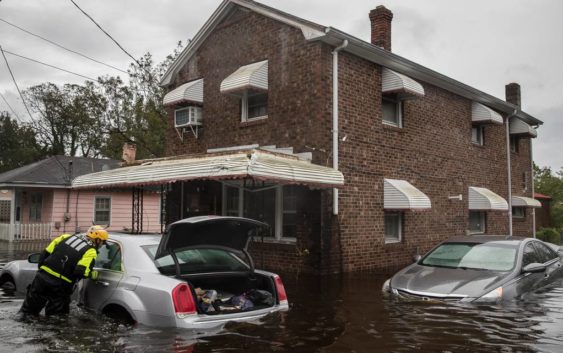- Rock Hill storm damage costs are 'somewhere around $5 million.' That number doesn't include damage to personal property
- Rock Hill storm damage costs are 'somewhere around $5 million.' That number doesn't include damage to personal property
- ‘Somewhere around $5 million’ | Rock Hill officials see major storm damage costs
- The deadliest tornadoes to ever hit Austin
- Whiteville resident recalls events from Tuesday nights tornado
Remnants of Florence continue to wreck havoc across the Carolinas Sunday

Remnants of Florence continued to batter the Carolinas Sunday as North Carolina Gov. Roy Cooper warned that “the risk to life is rising with the angry waters.”
Rivers continued to rise as much of eastern North Carolina remained flooded and the danger of flash floods spread throughout the state. The National Weather Service warned of possible tornadoes in the east as well as landslides in the mountains.
Downgraded Sunday to a tropical depression, former Hurricane Florence was blamed for at least 10 deaths in North Carolina. As many as 15,000 people remained stranded in more than 150 emergency shelters, Cooper told reporters at noon.
More than 712,000 customers remained without power in the Carolinas at noon. That was down from more than 1 million on Saturday as emergency crews worked around the clock. Those without power included about 18,000 Duke Energy customers in Mecklenburg County and nearly 2,800 Duke Energy Progress customers in Wake County.
Flooding closed more than 170 roads in North Carolina including portions of Interstates 95 and 40.
In Wilmington, an emergency official told reporters there was no longer any way in or out of the county by land.
“You can’t come yet. Please stay where you are,” New Hanover County Commissioner Woody White told reporters.
In Charlotte, there were closed roads and downed trees throughout the city, and Duke Energy reported that water could spill out of several of its lakes above and below Charlotte starting as early as Monday evening. The National Weather Service forecast up to 6 inches of rain in the area during the day and through Sunday night, with wind gusts as high as 30 mph.
The Triangle was spared the heaviest rain. Parts of Pittsboro received nearly 2 inches between midday Saturday and noon Sunday. Amounts in Wake County varied from half an inch to 1.72 inches in Holly Springs. A little more than an inch fell in Chapel Hill.
As of 11 a.m. Sunday, 5,706 Duke Energy customers were without power in Johnston County. Outages were fewer in Durham (906) and Orange (283).
And there was no major flooding on any of the Triangle’s most prone waterways — Crabtree, Marsh, Swift and Walnut creeks — the National Weather Service reported Sunday morning.
The storm’s sustained winds had fallen to 35 mph, the National Hurricane Center reported at 11 a.m. The storm itself was moving north-northwest at 10 mph and expected to turn east in the coming days through Pennsylvania and up to New England.
In eastern North Carolina, which took the brunt of the storm, flooding continued as at least four rivers, including the Neuse and Cape Fear, reached flood stage.
In Lumberton, Shakeia Bethea got a knock on her door around 12:30 a.m. Sunday. She was told to get out of her mobile home right away.
“They said the levee broke,” Bethea told the News & Observer. She had been in the same home in October 2016, when Hurricane Matthew flooded Lumberton, forcing thousands of people from their homes.
One emergency responder in Fayetteville told WRAL-TV that officials believe flood waters will be up to 4 feet above the level seen in Matthew.
In Marion County, S.C., more than 400 people were staying in three shelters, county administrator Tim Harper told The State.
The county had conducted about 100 swiftwater rescues from all over the county, he said. Florence has dumped about 13.3 inches of rain so far on Marion County – the most in the state, according to the S.C. Emergency Management Division – and county officials expect another 5 to 10 inches, Harper said.
“It has been raining nonstop,” Harper said. “The water has nowhere to go.”
Martha Quillin of the News & Observer and Avery Wilks of The State newspaper contributed.
Jim Morrill, 704-358-5059; @jimmorrill